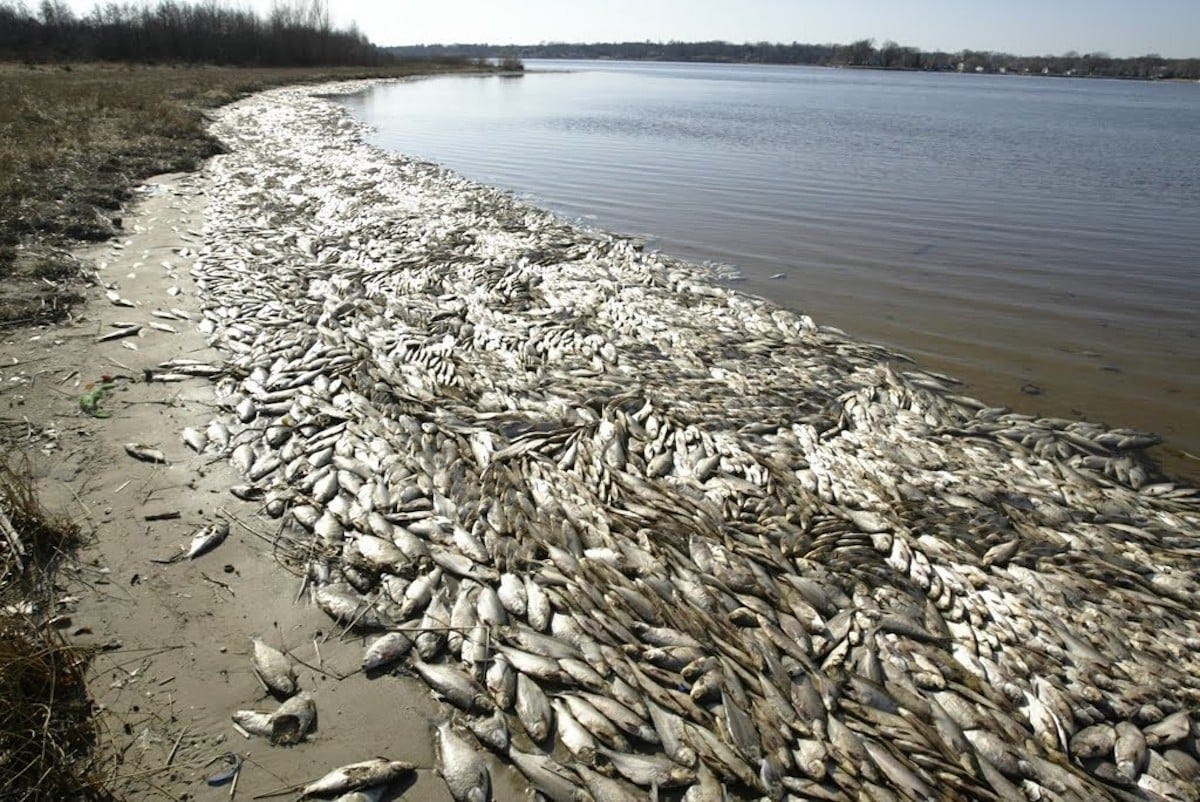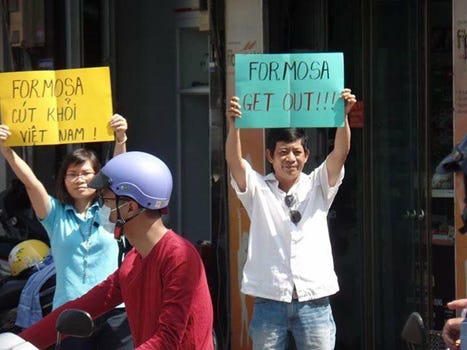Viet Villagers Still Seek Justice in Steel Mill's Toxic Spill
Activists go to jail for speaking out against Taiwan steel giant’s pollution disaster
In April 2016, 70 tons of fish washed up across 200 km of shore in north central Vietnam due to a toxic waste spill including phenol, cyanides, and iron hydroxides, by Formosa Ha Tinh Steel (FHS), a subsidiary of the Taiwan-based Formosa Plastics Group. It would be Vietnam’s worst peacetime environmental disaster ever.
Fishing, the main source of income for the nearby villagers, was destroyed along with their wellbeing. It was Vietnam’s worst-ever industrial disaster, generating protests across major cities in quest of justice. Logically, what should have happened next is that Formosa Steel would have been hit with massive sanctions and demands for compensation. But there are sensitivities. Taiwan is Vietnam’s fourth largest investor and fifth largest trading partner.
Instead, Võ Tuấn Nhân, the Deputy Minister of Natural Resources and Environment, first claimed that the two main suspects of the marine life destruction were red tide and toxins generated by villagers, refusing to acknowledge any link between the mass fish deaths and the chemical spill. Then the company issued an apology and paid the government compensation of US$500 million without any consultation with the local people. What the villagers received is a pittance compared with their losses, they say.
A year later, Bạch Hồng Quyền, a local activist, organized a march of 2,000 participants to commemorate the incident, claiming damages from local authorities. In addition, the protestors wanted Formosa Steel to stop its operations in the country. Instead, provincial authorities accused Quyền of causing public disorder, a pattern repeated far too often, with more than 200 activists behind bars. Vietnam is currently the second biggest jailer of political prisoners in Southeast Asia, after only Myanmar, which has been embroiled in five years of civil war after a coup by a military junta destroyed democratic government.
Despite anticipating risks as an activist, Quyền couldn’t have expected that he would soon be wanted nationwide. Fortunately, he managed to escape to seek refuge in Thailand with his son. With the help of activists at home and abroad, in 2019 his family safely resettled in Canada, which he now calls his second home.
Yet, many of his colleagues are still in jail. Another protestor and labor activist, Hoàng Đức Bình, was sentenced to 14 years on charge of “abusing freedom and democracy to infringe upon the interests of the State.” Lê Đình Lượng, a journalist and protestor from the 2016 spill, was sentenced to 20 years in prison and five years of house arrest under charges of subversion under article 79 of the 1999 Penal Code for peacefully advocating for a clean environment and multi-party democracy. The 60-year-old activist, who has never admitted his crime, is now denied healthcare despite having serious health conditions.
“It was the last time Vietnam witnessed such a big-scale protest,” said Phạm Thanh Nghiên, a former prisoner of conscience and a freelance journalist. She participated in several protests, with a crowd in Saigon, where she then lived, and several times on her own.
Seeking justice abroad
For local people, it is not only unsafe to live and work in the affected areas but also unsafe to seek justice on their home soil. The state has brutally against those who have demanded justice for others.
In the book “An Overview of the Marine Life Disaster in Vietnam,” Phạm Đoan Trang and her group Green Trees Vietnam detailed how the lack of transparency and accountability of government at all levels hindered the investigation process, or hamstrung efforts to resolve the crisis. In 2020, Trang was sentenced to nine years in prison on charges of conducting propaganda against the state.
Far from acting on behalf of the vulnerable victims, the government has chosen to side with the perpetrators. Mai Tiến Dũng, the then-head of the Government Office, went on record as saying, “Don’t kick him when he is down,” calling the public not to further corner Formosa Steel when, he said, they had already offered an apology and compensation. A few days after the incident, the then Party chief Nguyễn Phú Trọng reportedly paid the visit to the company yet stopped short of bringing the incident up in conferring with the company’s board of directors.
In addition, according to the report by Green Trees, formally-registered domestic NGOs have shied away from the incident to avoid direct confrontation with the government. Domestic lawsuits denied lawsuits against Formosa.
As the victims have no legal recourse domestically, they have had little option but to seek justice with the support of overseas Vietnamese. As of 2025, almost 8,000 victims filed a lawsuit with the help of diasporic communities.
Founded in 2017, Justice for Formosa’s Victims (JfFV) is a non-profit organization based in the United States whose mission is to seek financial compensation for victims of the 2016 marine disaster caused by hazardous spills from a Formosa Plastics Corporation steel mill.
In August 2024, nine US members of Congress sent an appeal to the Vietnamese Prime Minister urging the Vietnamese government to cease all retaliatory actions against justice seekers, release prisoners of conscience and implement an independent study of the pollution in the area affected by the Formosa toxic spill. A year later, the letter has been met with complete silence.
In a September 2024 letter addressed to the Office of the United Nations High Commissioner for Human Rights, the steel company said it “strictly adheres to Vietnamese laws and international standards in implementing various environmental protection, industrial safety, and occupational health and safety measures.” In addition, the company called the disaster, which killed millions of fish and prompted 7,875 victims to file a lawsuit, nothing but an “isolated environmental accident.”
Also, according to the letter, the impact of the April 2016 event on the locals “was brought under control in the shortest time possible. In addition, the company says the plant achieved nearly full recovery by May 2018.
The Vietnamese government was in charge of distributing the damages paid by the company. Furthermore, the Ministry of Agriculture and Rural Development confirmed what it called the return to normalcy of the marine environment, and that the results of marine water quality testing had met national standards. The Ministry of Health has monitored the quality of fishing catches, including deep-sea ones.
In the same letter, the then-Prime Minister, Nguyễn Xuân Phúc, reportedly stated that the Vietnamese government had done their due diligence so that the fishing, aquaculture, fishery operation and salt production in the four central provinces, along with marine recreation areas and beaches, had returned to normal, and that consumers could now eat various types of seafood with confidence. Later in 2016, Taiwan Steel was fined again after it was discovered the US$11 billion steel plant’s employees had been surreptitiously burying toxic materials on a nearby farm.
The message was clear: the company only talked to the authorities, not to the victims.
Nonetheless, FHS stated that it took pride in its US$1 billion investment in various environmental initiatives in the country. In fact, the Vietnamese state-monopolized press highlighted a few of their feel-good activities but was silent on protests, such as those led by Bạch Hồng Quyền.
Those who did receive funds obtained lump sum payments of around US$765. Yet according to experts familiar with the story, Formosa made no mention of the amount of the US$500 million compensation in their financial report since 2016. State media says the compensation was “basically completed.”
Claiming damages difficult
While the government stressed the forgiving attitude, some Taiwanese politicians sought their own versions of the truth. Four months after the fish die-off, Taiwanese lawmaker Su Chih-feng, a member of the governing Democratic Progressive Party, reported encountering difficulties during her trip to Vietnam to learn more about the FHS scandal. The non-incidental issues she faced during the trip raise her concerns about the transparency of the Vietnamese government’s investigation, she said.
In the meantime, authorities in Taiwan have thrown up roadblocks over compensation. In October 2019, the Taipei District Court dismissed a lawsuit filed by nearly 8,000 Vietnamese fishermen against Formosa Plastics Group over the 2016 disaster, saying it had no jurisdiction to rule on the case.
The plaintiff's lawyers later filed an appeal, with Taiwan’s Supreme Court in November 2021, demanding the plaintiffs have their Power of Attorney documents notarized at the Taipei Economic and Cultural Office in Vietnam (TECO), a requirement supporters of the victims say poses security risks for both plaintiffs and their families.
According to Peter Nguyễn Văn Hùng, a Vietnamese-Australian Catholic priest and human rights activist based in Taiwan who has supported the victims, if the Taiwanese court continues to insist on such a requirement, ‘the lawsuit for compensation will continue to encounter 'difficulties.”
“Currently, only a few have been able to do this,” the priest said.
Collective action from the international community has yet to deliver justice for the 8,000-odd complainants, yet they continue to maintain hope.
’Hope' is always better, so I choose to continue doing even small things with JFFV and the NGOs in Taiwan.”



In 2019 I was on a motorbike tour of Vietnam, and the guide was telling us this disaster and its impact on the local community. Apparently (maybe exaggeration?) the Formosa reps told the fisherman "you can have the economy or you can have the environment, you can't have both".